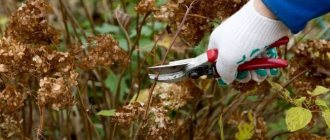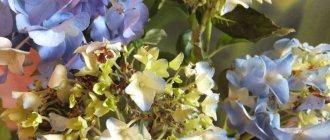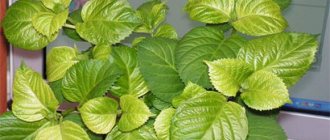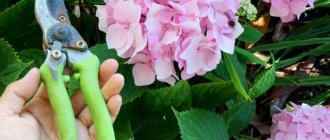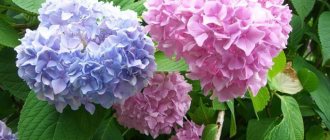Origin and appearance of hydrangea Early Sensation
The Early Sensation hydrangea variety owes its birth to chance. In 1991, an interesting non-standard seedling was discovered among hydrangea seedlings in a nursery in the Dutch city of Boskop.
Hydrangea blooms in late summer
According to the botanical description, it is a medium-sized bush with straight shoots of a brownish-reddish hue that do not require garter or support. It grows up to 1.5 m wide. The green oval leaves (unlike the wide leaves of large-leaved hydrangea) are rough to the touch, the edges are cut with small teeth.
How the Early Sensation hydrangea blooms
Hydrangea Early Sensation forms inflorescences on young, non-lignified shoots, and on last year's shoots. Blooms from early June until the first night frosts.
The racemose inflorescences are loose, reaching 30 cm in length. They consist of individual flowers, the diameter of which is 3-5 cm. The raceme contains sterile flowers of a pinkish tint and fertile cream flowers. The more large sterile flowers there are, the denser the inflorescence looks. The smell is pleasant, with a honey note, but weak.
Important! When pruning shrubs, you can create a new version of paniculata hydrangea in the form of a spreading tree. The culture looks impressive in standard form, but it will take about 8 years to create it.
During flowering, the petals change from a delicate pink hue to a rich purple or burgundy.
Description of the species
Early sensation (lat. early sensation) represents one of the many varieties of paniculate hydrangea (lat. hydrangea paniculata).
An adult specimen of early sensation paniculata hydrangea is an almost two-meter shrub.
Under normal conditions, the height of a flowering bush is 1.5-1.8 meters. The early sensation species is widely used by landscape designers along with other hydrangea paniculata, both for individual planting and for creating an ever-blooming garden.
The flowering of Early Sensation is vaguely reminiscent of lilac, with the difference that it lasts all summer.
Early sensation differs from other varieties of paniculate hydrangea by its earlier start of flowering. The first clusters of soft pink flowers open in early June. Early sensation blooms for three to four months, almost until the first night frost in September.
Early sensation inflorescences, like those of many hydrangea paniculata, are collected in loose clusters. The size of individual flowers reaches three to five centimeters in diameter. The diameter of the spherical brushes ranges from 20-30 centimeters. The high decorative value of the shrub is due to the changing range of inflorescences.
At the beginning of flowering, the brushes are painted in soft pink shades. Over time, the color of the flowers becomes more saturated, reaching a dark purple in late summer. At the peak of flowering, the pink foam almost completely hides the green foliage.
The early sensation type is distinguished by its high frost resistance.
Decorative flowering shrubs are not afraid of cold temperatures down to -29°C. The early sensation overwinters well without special shelter, continuing its annual vigorous flowering.
Transplanting hydrangea Early Sensation into open ground after purchase
Hydrangea Paniculata Strawberry Blossom - description
The best time for planting is April, when the threat of repeated frosts has passed: the seedlings will have time to take root and will survive the winter well. In September, hydrangea can only be planted in warm regions. When replanting a plant in the summer months, you will have to wait several seasons for flowering.
What is needed for planting
Hydrangea Early Sensation is unpretentious in cultivation, but it has the minimum conditions for a comfortable life:
- the right location;
- soil with a balanced pH level;
- compliance with the humidity regime.
When transplanting, a seedling with an open root system is treated in a solution to stimulate root formation.
The fence protects the bush from drafts
How to choose the optimal location
Hydrangea paniculata Sensation can reach 50 years of age, and this is taken into account when choosing a planting site in order to avoid problems.
Things to consider:
- The sun's rays should not scorch the bush at noon. It is better to focus on the western or eastern part of the site, where the plant will receive soft sunlight.
- Hydrangea does not like drafts, but the air in the area should circulate freely. Building walls and fences will be good protection. When landing, be sure to step back one and a half meters from them. In a heavily shaded place, the shrub stops flowering or its brushes become very small.
- A place near large trees is not suitable. They take a lot of moisture from the soil.
- The culture does not tolerate stagnant moisture. Areas with high groundwater and lowlands are not suitable for it.
Step by step planting process
Prepare the planting hole for the seedling in advance:
- At the selected location, scatter acidic high-moor peat (1 bucket per 1 sq. m) and dig it up along with the soil.
- Prepare a planting hole measuring 60 x 60 cm.
- A drainage layer and rotted pine needles are placed at the bottom of the hole to acidify the soil and the whole thing is covered with a layer of soil.
- In a bucket, mix humus or compost with acidic peat in equal proportions.
- The pit is filled 2/3 with this mixture.
- Add a handful of superphosphate.
- Water the hole generously.
The measures taken create slightly acidic soil, which paniculate hydrangea loves.
When planting a seedling, the root collar is not buried.
Transplanting a seedling with a closed root system
If the seedling has an open root system, then for planting it is placed on a mound of fertile soil and the roots are straightened. Fill the hole with the remaining soil mixture, leaving no voids among the roots, then compact it and water it again.
The last step after planting the seedling is mulching with pine sawdust or peat in a layer of up to 6 cm.
How to properly grow the Airlie Sensation variety?
The early variety of Hydrangea Early Sensation develops well in temperate climates. Many gardeners who grow this plant say that the shrub lives up to 60 years. Therefore, when planting, it is necessary to carefully select a permanent place for the young plant, so as not to have to replant in the future. The soil for paniculata Hydrangea should be slightly acidic and nutritious, the soil moisture is preferably moderate. When choosing a planting site, it is necessary that it is located away from drafts, and the lighting is preferably eastern or western. The plant is located at least 1.5 meters away from buildings. When growing such a plant, it is necessary to take into account that when combining several shrubs, it is impossible to shade Early Sensation, otherwise it will not bloom. The roots of the bush have a fibrous appearance, so they cannot fully saturate the above-ground part with moisture. When flower buds begin to form, the plant needs regular watering. To create moisture, mulch the soil around the bush. In normal weather, the plant is watered twice a week, the water should be soft and settled. Tap water leads to alkalization of the soil. During severe drought, the bush is watered every two days; if the summer is rainy, then the procedures are reduced to avoid stagnation of liquid. If the humidity is too high, the plant changes the color of the leaves.
Propagation of hydrangea Early Sensation
Even an inexperienced gardener can easily propagate hydrangea if he chooses the right option for himself.
Propagation by cuttings
Hydrangea Paniculata Magical Sweet Summer
Hydrangea Sensation is easily propagated by cuttings. Both green and lignified cuttings are suitable. The shoots remaining after pruning are suitable as lignified cuttings. They have a high survival rate.
Important! Cut cuttings with two internodes. The bottom cut is made at an angle of 45 degrees, the top cut is straight.
Rooted cuttings are transplanted to a permanent place after 2 months.
Growing from cuttings
Propagation by layering begins in early spring, before the buds open. Prepare the soil next to the bush: dig it, remove weeds, level it.
Healthy side shoots are placed in furrows up to 2 cm deep. The laid branches are fixed with staples, then sprinkled with earth.
The layer is ready for transplanting
Care consists of regular watering; there is no need to feed separately from the mother bush. To speed up the appearance of roots, they resort to constricting the cuttings with soft wire in front of the first bud. The emerging shoots are periodically spudded.
The young plant is separated and transplanted to a permanent place after a year.
Dividing the bush
All types of hydrangeas can be propagated by dividing the bush, except Hydrangea paniculata Early Sensation. With age, this shrub slows down the formation of new roots; wounds take a long time to heal.
Important! If replanting or dividing is necessary, the plant is well watered before digging. The survival rate of the cuttings is very low.
Description of the variety
The paniculate hydrangea "Early sensation" was accidentally bred by breeders in 1991, and in 2006 the variety was officially presented on the international market under the name Early sensation.
The shrub, covered with dark green leaf blades with teeth, grows up to 2 meters in height. Straight, elongated shoots are colored purple. Inflorescences can form both on last year’s branches and on those that grew only this year. Their length reaches 30 centimeters, and the diameter of one flower when open can vary from 3 to 5 centimeters.
Hydrangea blooms from June to September, almost completely hidden under a “cap” of beautiful flowers.
Each cone-shaped inflorescence is formed from neat flowers, the color of which changes from cream to pink. By the way, closer to autumn the main shade will change to purple. "Early Sensation" is characterized by very good frost resistance. The culture can withstand frosts down to -35 degrees, and even with slight freezing it recovers quite quickly.
The main disadvantage of this variety is considered to be a negative reaction to high humidity.
As the value increases, the petals become covered with unpleasant dots, which then transform into large spots of a gray hue. It is recommended to plant hydrangea on fertile soil with neutral or weak acidity. When living in a temperate climate and regular care, the crop can live from 50 to 60 years.
Caring for hydrangea Early Sensation
Hydrangea Diamond Rouge: how to grow in open ground, features of the variety
The Early Sensation variety is well adapted for growing in temperate climates. If you follow the basic rules, hydrangea will delight you with lush flowering for many years.
Watering mode
The shrub needs watering throughout the growing season. Its fibrous roots are located superficially and are not able to independently obtain moisture.
Water 2 times a week, taking into account weather conditions, preferably with soft, settled water to prevent alkalization of the soil. After moistening, the ground around the bush is mulched, slightly away from the trunk.
Top dressing
The choice of fertilizer for paniculate hydrangea depends on the season:
- nitrogen fertilizers are applied in the spring;
- At the beginning of budding, potassium fertilizers are used;
- In the fall, potassium-phosphorus fertilizing is carried out.
2-3 year old seedlings do not need feeding.
Features of care during the flowering period
For full flowering, the soil around the bush is loosened from time to time to ensure good aeration of the roots. Loosening should not be deeper than 5 cm; it is carried out after watering.
In summer, it is important to mulch the soil around the bush in order to retain moisture around the tree trunk longer. In mid-summer, a complex fertilizer is used, for example, “Kemira flower”, which helps the inflorescences bloom together and bloom for a long time.
Features of care during the rest period
After flowering, dried panicles are cut off. Branches can be shortened by 2/3 of the length.
Hydrangea Early Sensation can survive the winter without shelter
Preparing for winter
In late autumn, the bush is watered abundantly. This technique will help the roots increase frost resistance. Adult plants tolerate frosts down to 25 degrees; it is enough to lay a thick layer of mulch. Young plants up to 3 years old need additional shelter; frost resistance increases with age.
Winter hardiness and long-lasting lush flowering attract the attention of gardeners from many regions of Russia to Early hydrangea. The shrub looks good in group plantings and as a tapeworm. Caring for it is simple, so this plant is worth placing in the garden to admire its beautiful flowering.
Features of care
Let's find out what kind of care will ensure the successful functioning and long flowering of this magnificent ornamental shrub.
Watering
Since the root system of the plant is superficial, it cannot take moisture from deep layers of soil. Therefore, regular and sufficiently abundant watering is so important when growing a flower. Watering should begin in the spring, as soon as the buds begin to form, and end only before snow falls in the fall. Before wintering, it is recommended to moisten the plant especially abundantly: this will increase the frost resistance of its roots.
The average frequency of watering in normal weather is twice a week. If it is too dry and hot outside, watering is carried out after 2-3 days. And in damp, rainy weather, it is better to postpone the next moistening procedure in order to prevent the formation of a swamp in the flowerbed.
The water should be soft and not too cold. Pre-settle tap water, otherwise, due to its high chlorine and lime content, it will quickly make the soil alkaline.
Important: after watering, it is recommended to mulch the soil in the flowerbed. This technique will help keep the roots moist for a longer period.
Top dressing
In early spring, you need to feed the hydrangea with a complete complex fertilizer. During the period of bud formation, a second feeding is carried out using fertilizers with a low nitrogen content. In the fall, it is recommended to add potassium and phosphorus to better prepare the plant’s roots for the upcoming cold weather.
Trimming
Hydrangea Early Sensation is pruned annually. The procedure is carried out in the spring, choosing the time early, before the sap begins to flow. When pruning, you should shorten all shoots of the bush by about a third of the length, if the branches are damaged, then even more. Be sure to get rid of shoots that grow inside the crown and are frozen over the winter, weak, or rotten.
Keep in mind that flower buds are formed in this case on last year’s shoots and the current year’s. Therefore, you can painlessly and without consequences part with all shoots older than two years of age, and one-year-olds and shoots with new buds should be left as much as possible.
Note that the plant tolerates a haircut easily and quickly recovers after it, increasing its previous volume and splendor. On the contrary, after regular pruning the bush seems to come to life, becoming more beautiful and elegant. In addition, it already gets rid of many pests and diseases by removing old broken branches.
If high-quality shoots remain after pruning, they can easily be used for further rooting. This is exactly what most competent gardeners do. Note that semi-lignified hydrangea cuttings take root almost 100% after cutting.
Attention: if the main procedure is carried out in the fall, then in the spring only sanitary pruning is needed. But in the fall, it is recommended to shorten the shoots further - by two-thirds of the length.
Wintering
The plant has quite decent frost resistance, so wintering it does not pose any special problems. Without shelter, the shrub can survive even 29-degree frosts, but only if they are short-lived. If the climate in your area is more severe, it is still recommended to insulate the plant before winter.
If we are talking about hydrangeas of the first and second years of life, it is recommended to insulate them in any case. This does not require much work - you just need to cover the bush with spruce branches, sprinkle the root circle with bark, sawdust or dry straw.
Important: the frost resistance of the plant becomes higher with age.
We were introduced to a beautiful hydrangea called Early Sensation. This garden shrub pleases with its beauty throughout the summer, has high cold resistance, and is not too demanding to care for. Growing a flower is not difficult: by applying the simple recommendations from our article in practice, even an inexperienced gardener can cope with the task.
Beautiful examples in landscape design
Hydrangea "Early Sensation" has all the qualities necessary to decorate a garden plot. It retains its decorative appearance for a long time, always looks neat and is quite resistant to diseases and insects. In addition, it is quite easy to grow and requires minimal care.
Hydrangea of this variety is planted both individually and in group compositions with other crops.
When choosing neighbors, it is important not to forget about compliance with soil and fertilizing requirements, and also to ensure that the hydrangea does not fall into heavy shade. Hydrangeas are used as a hedge or small border. The plant can become a background for brighter flowers or, conversely, occupy the center of the composition.
In the next video you will learn how to properly plant the Early Sensation hydrangea.
